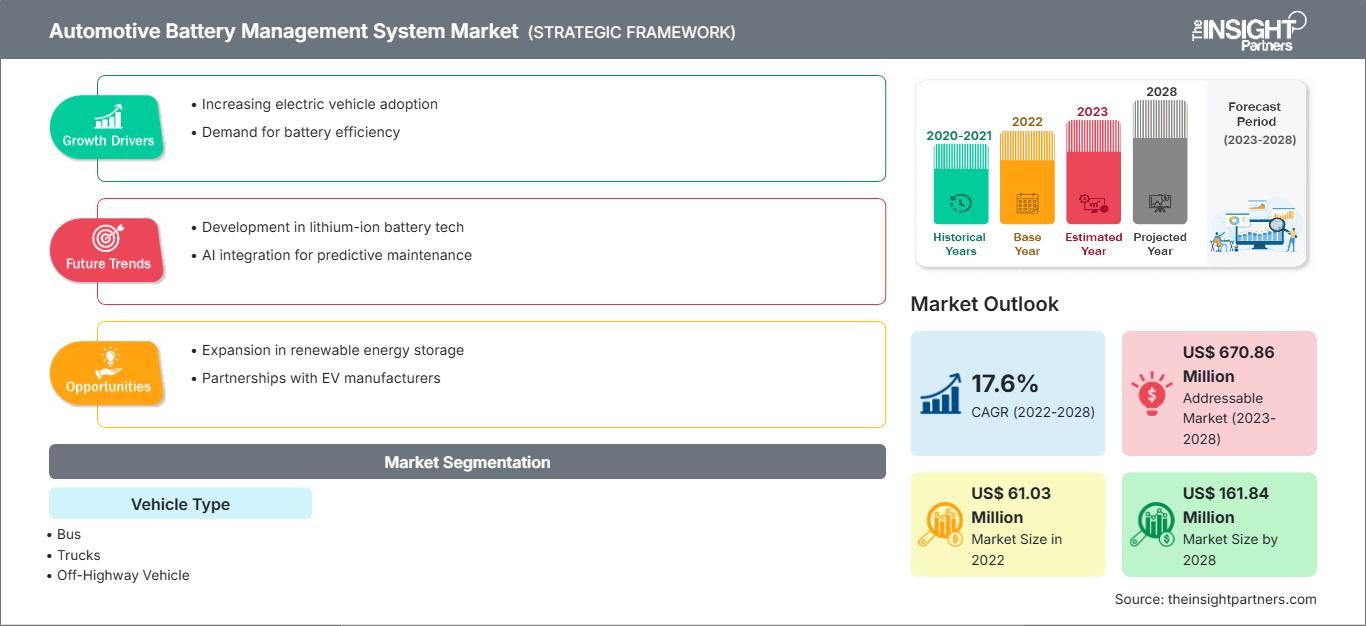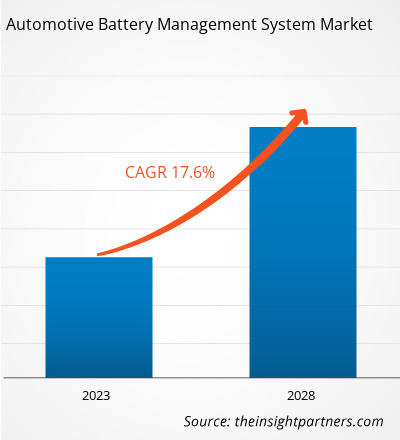Der Markt für Batteriemanagementsysteme für Kraftfahrzeuge soll von 61,03 Millionen US-Dollar im Jahr 2022 anwachsen; von 2022 bis 2028 wird ein CAGR von 17,6 % geschätzt.
Ein Batteriemanagementsystem verwaltet Batterien, die in Hochvolt-Hybrid- und Elektrofahrzeugen verwendet werden. Hersteller von Elektrofahrzeugen und Batteriepacks integrieren ein Batteriemanagementsystem in Lithium-Ionen-Batterien, um den Batteriepack zu schützen. Das gesamte Batteriesystem in einem Elektrofahrzeug ist eine Kombination aus mehreren Komponenten wie Batteriemodulen, Sensoren, Steuerungen, Wärmemanagementsystemen und Batteriemanagementsystemen. Angesichts des zunehmenden Umweltschutzes und der positiven Initiativen der Regierungen zur Emissionsreduzierung wird die Nachfrage nach Elektro- und Hybridfahrzeugen im Prognosezeitraum 2022 bis 2028 voraussichtlich rasant steigen. Dies wiederum wird das Marktwachstum für Batteriemanagementsysteme für Kraftfahrzeuge ankurbeln.
Die globale Elektrofahrzeug- und Batteriepackbranche ist durch die Präsenz einiger sehr bekannter und finanzkräftiger Unternehmen wie Mitsubishi, Nissan und Tesla gekennzeichnet. Aus diesem Grund ist die Verhandlungsmacht der Käufer auf dem Markt für Batteriemanagementsysteme für Kraftfahrzeuge recht hoch. Aufgrund der kontinuierlichen Forschung und Entwicklung im Bereich Elektrofahrzeuge und des schnellen Wachstums des Marktes für Batteriemanagementsysteme für Kraftfahrzeuge wird die Verhandlungsmacht der Käufer zwischen 2019 und 2027 voraussichtlich hoch bleiben. Die großen Unternehmen auf dem Markt für Batteriemanagementsysteme für Kraftfahrzeuge verfolgen bei der Planung von Batteriesystemen für ihre Fahrzeuge unterschiedliche Strategien. Kontinuierliche Fortschritte im Technologiesektor werden voraussichtlich Druck auf die Anbieter von Batteriemanagementsystemen ausüben, sich an die Veränderungen anzupassen, um ihre Marktposition zu behaupten. Aus diesem Grund neigen Käufer auch stark dazu, im Laufe der Zeit den BMS-Anbieter zu wechseln, abhängig von ihren spezifischen Anforderungen und dem Technologieportfolio der BMS-Anbieter.
Passen Sie diesen Bericht Ihren Anforderungen an
Sie erhalten kostenlos Anpassungen an jedem Bericht, einschließlich Teilen dieses Berichts oder einer Analyse auf Länderebene, eines Excel-Datenpakets sowie tolle Angebote und Rabatte für Start-ups und Universitäten.
Markt für Batteriemanagementsysteme für Kraftfahrzeuge: Strategische Einblicke

-
Holen Sie sich die wichtigsten Markttrends aus diesem Bericht.Dieses KOSTENLOSE Beispiel umfasst Datenanalysen, die von Markttrends bis hin zu Schätzungen und Prognosen reichen.
Auswirkungen der COVID-19-Pandemie auf den Marktanteil von Batteriemanagementsystemen für Kraftfahrzeuge
Der COVID-19-Ausbruch hatte auf seinem Höhepunkt im Jahr 2020 dramatische Auswirkungen auf die Weltwirtschaft und behinderte die Geschäftsaktivitäten in der Fertigungsindustrie. Vor dem Ausbruch erlebte der Marktanteil von Batteriemanagementsystemen für Kraftfahrzeuge aufgrund des gestiegenen Absatzes von Elektrofahrzeugen, des stark gestiegenen verfügbaren Einkommens und der einfachen Verfügbarkeit von Krediten und Finanzierungen ein beträchtliches Wachstum. Darüber hinaus treiben erhebliche Investitionsinitiativen zur Entwicklung von Elektrofahrzeugen die Nachfrage nach Batteriemanagementsystemen für Kraftfahrzeuge an. Laut dem International Council on Clean Transportation erreichten die weltweiten Verkäufe von Elektrofahrzeugen im Jahr 2021 einen Rekordwert von 6,9 Millionen, ein Anstieg von 107 % gegenüber 2020. Der Ausbruch der COVID-19-Pandemie bremste jedoch die Investitionen in und die Produktion von Elektrofahrzeugen. In den ersten Tagen der Pandemie schränkte die Krise alle Geschäftsabschlüsse, Kooperationen und Partnerschaften, die den Markt für Batteriemanagementsysteme für Kraftfahrzeuge störten, erheblich ein. Der Ausbruch der Pandemie behinderte den Fahrzeugabsatz im Februar 2020; darüber hinaus gingen die Verkäufe bis April in den USA um 47 % und in Europa um 80 % zurück. Einem Bericht von Statista zufolge sanken die weltweiten Autoverkäufe im Jahr 2020 auf 63,8 Millionen und erholten sich 2021 langsam mit 66 Millionen Verkäufen.
Markteinblick – Markt für Batteriemanagementsysteme für Kraftfahrzeuge
Steigende Verkäufe von Elektrofahrzeugen und Ausbau der Infrastruktur für Elektrofahrzeuge
Die Verkäufe von Elektrofahrzeugen (EV) wachsen aufgrund zunehmender Bedenken hinsichtlich des Umweltschutzes und staatlicher Maßnahmen, die die Einführung emissionsarmer und emissionsfreier Fahrzeuge fördern, rasant. Staatliche Subventionen und Steuererleichterungen ermutigen Hersteller, ihre Prozesse zu skalieren. Laut Global Electric Vehicle Outlook erreichten die Verkäufe von Elektroautos, einschließlich vollelektrischer und Plug-in-Hybridfahrzeuge, im Jahr 2021 6,6 Millionen Einheiten. Im selben Jahr stiegen die Verkäufe in China sprunghaft auf 3,3 Millionen und machten damit etwa die Hälfte der weltweiten Verkäufe aus. Darüber hinaus stiegen die Verkäufe von Elektrofahrzeugen in Europa um 65 % auf 2,3 Millionen Einheiten, während sich die Verkäufe in den USA im Jahr 2021 auf 630.000 Einheiten verdoppelten. Steigende Investitionen in die Ladeinfrastruktur und eine Zunahme günstiger staatlicher Maßnahmen treiben die Batterieproduktion voran und stärken so die Nachfrage nach Batteriemanagementsystemen für Kraftfahrzeuge.
Einblicke nach Fahrzeugtypen
Basierend auf dem Fahrzeugtyp ist der Markt für Batteriemanagementsysteme für Kraftfahrzeuge in Busse, Lkw und Geländefahrzeuge unterteilt. Im Jahr 2022 hatte das Bussegment den größten Anteil am Markt für Batteriemanagementsysteme für Kraftfahrzeuge, da in Bussen zunehmend Batterien zur Reduzierung der CO2-Emissionen eingesetzt werden. Darüber hinaus wird für das Lkw-Segment im Prognosezeitraum die höchste durchschnittliche jährliche Wachstumsrate (CAGR) prognostiziert. Die Nachfrage der Hersteller von Elektrobussen nach Batteriemanagementsystemen steigt aufgrund zunehmender Initiativen zur optimalen Batterieleistung und Überwachung der Batteriepacktemperatur deutlich an. Darüber hinaus steigt in verschiedenen Ländern der Bedarf an elektrischen Schulbussen, um den CO2-Ausstoß zu reduzieren. Dies ermöglicht den Herstellern von elektrischen Schulbussen, ihre Produktionslinien zu erweitern. Mehrere Regierungen verschiedener Länder setzen auf Busse mit umweltfreundlicher Technologie, was die Nachfrage nach elektrischen Reisebussen ankurbelt und somit das Wachstum des Marktes für Batteriemanagementsysteme für Kraftfahrzeuge fördert.
Batteriemanagementsystem für Kraftfahrzeuge
Regionale Einblicke in den Markt für Batteriemanagementsysteme für KraftfahrzeugeDie Analysten von The Insight Partners haben die regionalen Trends und Faktoren, die den Markt für Batteriemanagementsysteme für Kraftfahrzeuge im Prognosezeitraum beeinflussen, ausführlich erläutert. In diesem Abschnitt werden auch die Marktsegmente und die geografische Verteilung von Batteriemanagementsystemen für Kraftfahrzeuge in Nordamerika, Europa, im asiatisch-pazifischen Raum, im Nahen Osten und Afrika sowie in Süd- und Mittelamerika erläutert.
Umfang des Marktberichts zum Batteriemanagementsystem für Kraftfahrzeuge
| Berichtsattribut | Einzelheiten |
|---|---|
| Marktgröße in 2022 | US$ 61.03 Million |
| Marktgröße nach 2028 | US$ 161.84 Million |
| Globale CAGR (2022 - 2028) | 17.6% |
| Historische Daten | 2020-2021 |
| Prognosezeitraum | 2023-2028 |
| Abgedeckte Segmente |
By Fahrzeugtyp
|
| Abgedeckte Regionen und Länder |
Nordamerika
|
| Marktführer und wichtige Unternehmensprofile |
|
Dichte der Marktteilnehmer für Batteriemanagementsysteme für Kraftfahrzeuge: Verständnis ihrer Auswirkungen auf die Geschäftsdynamik
Der Markt für Batteriemanagementsysteme für Kraftfahrzeuge wächst rasant. Dies ist auf die steigende Nachfrage der Endverbraucher zurückzuführen, die auf Faktoren wie veränderte Verbraucherpräferenzen, technologische Fortschritte und ein stärkeres Bewusstsein für die Produktvorteile zurückzuführen ist. Mit der steigenden Nachfrage erweitern Unternehmen ihr Angebot, entwickeln Innovationen, um den Bedürfnissen der Verbraucher gerecht zu werden, und nutzen neue Trends, was das Marktwachstum weiter ankurbelt.

- Holen Sie sich die Markt für Batteriemanagementsysteme für Kraftfahrzeuge Übersicht der wichtigsten Akteure
Akteure auf dem Markt für Batteriemanagementsysteme für Kraftfahrzeuge konzentrieren sich hauptsächlich auf die Entwicklung fortschrittlicher und effizienter Produkte.
- Im August 2021 gaben Varta, ein Batterieexperte, und Continental Engineering Services (CES), ein Anbieter von Entwicklungs- und Produktionsdienstleistungen, ihre Zusammenarbeit bekannt. Im Rahmen eines ersten Pilotprojekts haben die beiden Partner gemeinsam einen austauschbaren 48-Volt-Akku für elektrisch angetriebene Zweiräder mit einer Leistung von 10 kW und mehr entwickelt.
- Im Juni 2021 gab Carrar, ein israelisches Unternehmen, das hochwertige Wärmemanagementsysteme für die Elektromobilitätsbranche herstellt, bekannt, dass Gentherm, ein Marktführer und Entwickler hochmoderner Wärmemanagementlösungen, der Hauptinvestor einer Seed-Finanzierungsrunde ist.
Der Markt für Batteriemanagementsysteme für Kraftfahrzeuge ist in fünf Hauptregionen unterteilt: Nordamerika, Europa, Asien-Pazifik (APAC) und Rest der Welt. Im Jahr 2022 war der Asien-Pazifik-Raum mit einem beträchtlichen Umsatzanteil der Marktführer, gefolgt von Europa. Darüber hinaus wird für den asiatisch-pazifischen Raum von 2022 bis 2028 die höchste durchschnittliche jährliche Wachstumsrate (CAGR) erwartet.
Continental AG; Dana Limited; GENTHERM; Hanon Systems; Mahle GmbH; NXP Semiconductors; Renesas Electronics Corporation; Robert Bosch GmbH; Valeo; und Marelli Holdings Co., Ltd. gehören zu den wichtigsten Akteuren auf dem Markt für Batteriemanagementsysteme für Kraftfahrzeuge. Der Marktbericht bietet detaillierte Markteinblicke, die den wichtigsten Akteuren helfen, das Wachstum in den kommenden Jahren zu planen.
- Historische Analyse (2 Jahre), Basisjahr, Prognose (7 Jahre) mit CAGR
- PEST- und SWOT-Analyse
- Marktgröße Wert/Volumen – Global, Regional, Land
- Branchen- und Wettbewerbslandschaft
- Excel-Datensatz
Aktuelle Berichte
Verwandte Berichte
Erfahrungsberichte
Grund zum Kauf
- Fundierte Entscheidungsfindung
- Marktdynamik verstehen
- Wettbewerbsanalyse
- Kundeneinblicke
- Marktprognosen
- Risikominimierung
- Strategische Planung
- Investitionsbegründung
- Identifizierung neuer Märkte
- Verbesserung von Marketingstrategien
- Steigerung der Betriebseffizienz
- Anpassung an regulatorische Trends






















 Kostenlose Probe anfordern für - Markt für Batteriemanagementsysteme für Kraftfahrzeuge
Kostenlose Probe anfordern für - Markt für Batteriemanagementsysteme für Kraftfahrzeuge